American Sabbatical 005: 9/2-3/96
Seneca Falls
9/3.. Seneca Falls.
We followed along the canal in a sweaty snarl of the season’s finale, and I got into the
mood. Bored and bitchy. Even the appearance of masses of wild
black-eyed susans, chicory, and acres of goldenrod couldn’t jolly
me. Is this how it’s going to be? Peggy all abubble with anectoids,
and the driver grumbling? The KOA norwest of Syracuse is down
behind the turkey farm. Just right, I figured. In a marshy wasteland
alongside the Seneca River, with bugs and jet skis for ambiance.
Bad water and kids with firecrackers to top it off.
| We got up with the sun and skedaddled. The temples of corn were
glistening in the hazy morning light, and whiffs of side-dressing
danced in the air. My time sense is almost an hour off here toward
the west end of the time zone. Do people live an hour later here?
Our first stop was in Auburn, a decaying city whose major industries
have fled, and where the state is the biggest employer. Still
a pleasant town, where people have the time to tell you all the
bad news over cheap coffee. Breakfast for two, $3. |
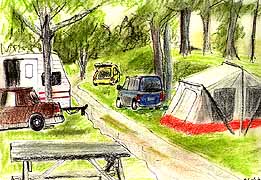
KOA Seneca (Peggy)
|
One of those serendips of the trail: we found that Harriet Tubman’s
house is here in town, so we visit. But it’s not open. While I
do a sketch, Peggy weeds the flower beds. The sight of a history
teacher weeding Harriet Tubman’s garden left me a bit light-headed.
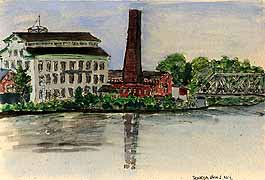
Mills at Seneca Falls (Bryce)
|
In fact, the rest of the day was a joy. We drove into Seneca falls,
birthplace of women’s rights, in high chuckle. While Peggy did
the museum thing I wandered the town. It’s young, full of life
and warmth (a chiropractic college, they said), and all to human
scale. Then I sketched along the canal. Or river, as it is here;
but very much the real thing. Big locks, boats of passage from
the great lakes, the whole bagel. There is still life along the
Erie Canal, everybody down. |
(Memo#5)
|
Sept. 3 - (1) HARRIET TUBMAN (2) SENECA FALLS CONVENTION
Who? Harriet Tubman, Elizabeth Cady Stanton, Lucretia Mott , Frederick
Douglass.
What? Tubman's final home. First Women's Rights Convention in
world, 1848. ("Declaration of Women's Rights and Sentiments")
Where? Auburn, New York
Seneca Falls, New York
When? JULY 1848
How? local publicity lured 300 people to the convention
Topics: Tubman - abolition, Underground Railroad, women’s rights,
1848 convention, women’s liberation movement 1970’s, abolitionists,
QUAKERS, current cases of human rights, group protest for rights.
Questions: Are there time periods of inevitable change? How does
one reform movement (like abolition) spark others (like women’s
rights)? How can/should the US fulfill its promise of rights for
ALL?
|
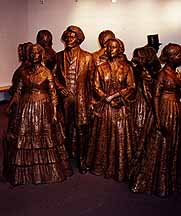
History in Bronze
|
We set off early for Auburn, New York, a large town near the canal.
Another central New York city that is dying in spite of attractiveness,
good location, water source. The thruway bypassed it, and six
hundred other towns, by. We are taking old Route 20 west through
all the lovely forgotten towns. We are trying not to take any
major highways, but have already broken our rule occasionally.
What are the advantages and disadvantages of thruways? I’m seeing
the disadvantages.
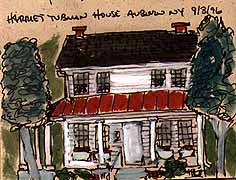
Bryce Drawing while Peggy weeds
|
HARRIET TUBMAN - Harriet Tubman chose to make her base at the
end of her life in Auburn, New York. We sought out the house,
driving out a major street past huge gorgeous houses with large
lots and big trees. We passed the Seward House (he was in Lincoln’s
cabinet, and another focus of the assassination plot that killed
Lincoln) - huge brick mansion with gatehouse and ornamental fence
enclosing several well-groomed acres. Further out of town we descend
slightly into an area of modest homes and pastures. Tubman’s house
is a white frame farmhouse on several acres. Tours were not given
until much later in the day, so we walked and photographed. |
Harriet Tubman is best known as the “Moses of her people”, an
escaped slave who went south many times to rescue other slaves
and bring them north before the Civil War. During the Civil War
she worked as a spy for the North. Why did she settle in late
life (after the war) in Auburn? I suspect it was an abolitionist
center with a group of supportive “friends” (literally, the “Friends”
or Quakers had lead the abolitionist movement since the religion’s
foundation. Friends support total EQUALITY OF MEN AND WOMEN AND
ALL RACES. THEIR CHURCH ALLOWS WOMEN TO BE LEADERS. THEIR FIRST
ANTI-SLAVE ACTION WAS, I BELIEVE, IN THE 1780’S). Also Auburn
was probably on the route to Canada she had frequented as a conductor
on the Underground Railroad.
| The plaques at the house called it her “Home for the Aged”. And
said she “frequented” the site. I was interested that they didn’t
say she “lived” there. Maybe she made a place for ex-slaves that
she would visit regularly. She may have settled when she was less
physically active. Frustrating not to get the full tour. I have
many questions still. |
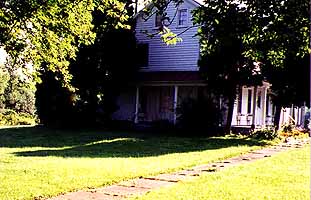
Tubman House
|
SENECA FALLS - 1848 - Another central New York town at the center
of history. In July of 1848 the first women’s rights convention
was held at a Methodist chapel in the middle of town. It was called
by Elizabeth Cady Stanton and Lucretia Mott, both pioneers of
women’s rights - for different reasons. Stanton was the daughter
of a prominent lawyer and had become aware of women’s problems
as a child seeing the women come to her father for legal advice.
At that point married women did not own their own property. A
divorce could be a total disaster, not only financially but emotionally
since the father got custody of the children. Elizabeth was an
excellent student and wanted the chance to go to college, but
no colleges were educating women. She studied on her own and was
given the chance to attend an academy for further study.The causes
all arise together- rights movements include legal rights, educational,
financial, etcetera.
(It was women like Emma Willard and Mary Lyon who started the
famous women’s colleges. Oberlin College educated women early.
In the mid 1800s a whole slew of colleges for women were started
- Smith, Wheaton, Wellesley, etc. Most went coed in the 1960’s
and 1970’s. Mount Holyoke, Wellesley, and Smith in Massachusetts
remain women’s schools. A lot of people debate the value of single
sex schools. I went to an all-girls high school and loved it AND
had a great social life.)
Elizabeth Cady married Henry Stanton and on her honeymoon went
to a huge WORLD ABOLITIONIST CONVENTION in London in 1840. There
she met the Motts, abolitionists representing a Philadelphia group
(Lucretia had been elected as part of the delegation). At the
Convention many male delegates were appalled that the American
contingent included women. A major debate broke out the first
day, and the convention voted to exclude women from the floor,
but let them observe from the balcony. In outrage, William Lloyd
Garrison ( perhaps the most famous American abolitionist of the
1800’s) sat in the balcony with the women.
So began a key friendship. The delegates returned to America.
Lucretia and Elizabeth corresponded. The Stantons had a number
of children, and moved eventually to Seneca Falls. The Motts visited
the area in 1848, and the women got together with three other
friends. The tea-drinking women planned a rights convention. They
sent out notices, Frederick Douglass published word in his newspaper
in Rochester and went to the convention. The women expected perhaps
50 people; 300 attended.
Several things happened at Seneca Falls. The organizers had drafted
a “Declaration of Rights and Sentiments” patterned on the Declaration
of Independence that states, “We hold these truths to be self-evident,
that all men and women were created equal...” Many people present
signed it. AND links were established between people wanting change,
a network of reformers who went back to their towns and villages
and carried the message of Seneca Falls. Other national conventions
were held. Women’s organizations were started. It took 72 more
years for women to get the right to vote nationally (1920), but
other rights were achieved beforehand - for example Maine, then
New York passed a married women’s property act, and several western
states allowed women to vote in state elections. Women’s colleges
were opened as were some professions (for example, women began
to attend medical college).
| The building where the convention was held went through many changes
and served as a store and theater. Its last incarnation was -
appropriately- as a laundromat. Today it is a beautiful historic
site. It’s right on the main street of this lovely town. Only
two brick walls remain of the original building. The rest of the
structure is bare beams open to the air, so you are in a space
that is enclosed and roofed and yet not. Next to it is a large
open amphitheater where special programs can be given. A water-wall
lines one edge of the lot, the water soothing. The inscription
behind the falling water is from the declaration of the convention.
|
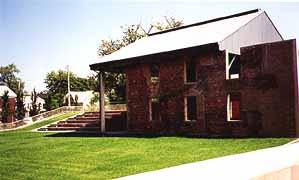
Seneca Falls Memorial
|
Next door is a three-story building with displays and a bookstore.
As you enter the building you see full size bronze statues of
the key people at the convention - Elizabeth Stanton, the Motts,
Frederick Douglass. Upstairs is a major exhibit with both cases
and artifacts and interactive videos. There was a display on sports
and women with early wooden barbells, another on clothing, another
on cosmetics and women’s images, another on labor.
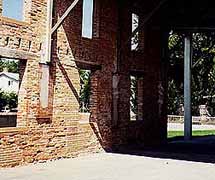
The Wall
|
One video introduced important legal cases, you could press buttons
to see the arguments on each side and the decisions. One of the
most interesting was the case surrounding the draft. The Supreme
Court decided women could be excluded from the draft. Why would
women WANT to be drafted, people might ask? As one of the responsibilities
of citizenship that go along with privileges, is one answer. Another
is that military service has always been an avenue to professional
training and success in the US - servicemen can go to college
on the GI Bill, get cheap VA mortgages, get training as air traffic
controllers and engineers, etc. Another is the notion that any
discrimination is wrong - why, I wondered during Vietnam, was
it considered better to draft the sons and brothers and husbands
and boyfriends? |
The debate continues today. Should servicewomen be in combat?
Should they serve in submarines. Are women strong enough for various
tasks? Do they need to be? And on and on.
| Another fascinating interactive video was on medical research.
Many baseline studies were done only on men. Some people argue
that they must be continued on a test group only of men to make
the studies consistent. Some argue that women’s cycle and hormonal
changes skew the data. The other side argues that that is precisely
why we need more research on women. How can a doctor prescribe
medicine or treatment for women whose bodies are different, when
the studies are about men? Should more research money be funneled
into studying diseases that hit women especially (like breast
cancer)? |
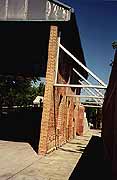
and Again
|
Seneca Falls definitely leads to thought about women’s rights,
but also to rights in general and the key American task of extending
rights to all - the 1970’s saw the extension of rights to the
handicapped. If people have THE RIGHT to access to public places,
then it followed that parking spaces and ramps and special toilet
stalls were necessary for the handicapped. The elderly have pushed
for rights. How can we end discrimination based on weight and
race and age and... Right from the beginning this country has
been committed to rights for all. George Washington and Thomas
Jefferson saw the dilemmas - how could a country that broke from
England to get rights keep people as slaves? Seneca Falls was
part of the movement to give rights to women.
Today one of the most interesting rights campaigns concerns rights
for children. Children don’t vote - who represents them?They are
legal minors - what are their rights?







